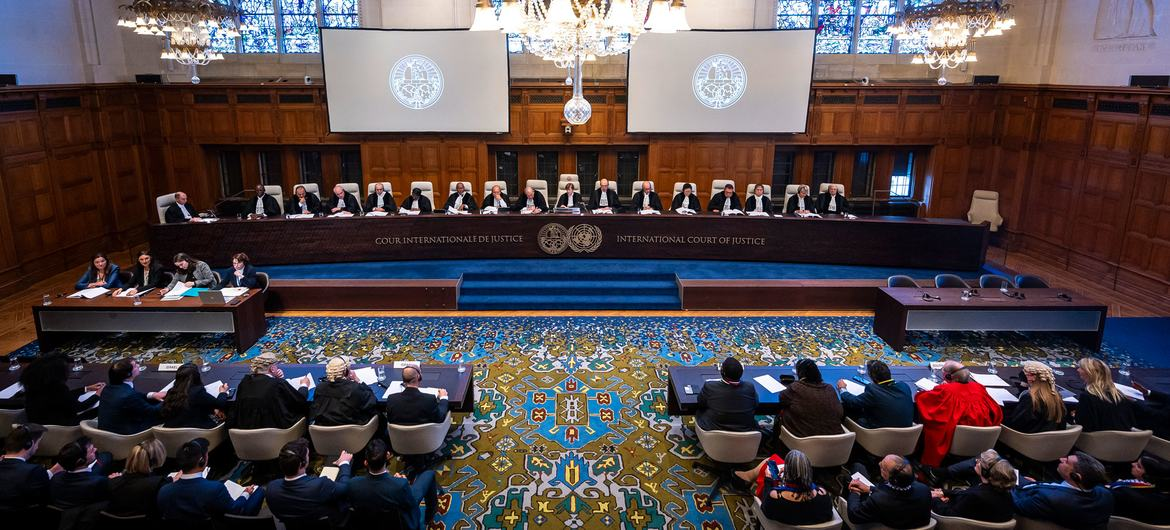Foreign News
UN world court calls for prevention of genocidal acts in Gaza

The International Court of Justice (ICJ) on Friday declared that Palestinians had a right to be protected from acts of genocide, calling on Israel to “take all measures within its power” to prevent such actions and allow the entry of desperately needed humanitarian aid into the war-shattered enclave.
Reading out the order at the Peace Palace in The Hague – in response to allegations of genocide against Israel by South Africa, which Israel denies –ICJ President Joan Donoghue also called for the release of all remaining hostages taken from Israel during the Hamas-led attacks on Israeli communities in which some 1,200 people were massacred on 7 October.
There was no explicit call for an immediate halt to Israel’s full-scale military operation in the Strip, which is believed to have left more than 26,000 dead, according to Gaza health authorities.
Highlighting that the ICJ was “acutely aware of the extent of the human tragedy unfolding in the region” since war erupted in Gaza, Judge Donoghue said that the court remained “deeply concerned about the continuing loss of life and human suffering”.
The UN Secretary General Antonio Guterres noted in a statement the measures pertaining to the Israeli military laid out in the provisional ruling and stressed that “decisions of the Court are binding” and trusts that all parties will duly comply with the order from the Court.
“In accordance with the Statue of the Court, the Secretary-General will promptly transmit the notice of the provisional measures ordered by the court to the Security Council,” UN Spokesperson Stéphane Dujarric said.
In its case, which began earlier this month in The Hague, South Africa asked the court – a principal organ of the UN – to indicate provisional measures in order to “protect against further severe and irreparable harm to the rights of the Palestinian people under the Genocide Convention“.
Among the measures South Africa asked for was the immediate suspension of military operations by Israel in the Strip and that its forces take “all reasonable measures” to prevent genocide.
South Africa also asked the world court to order Israel to prevent forced displacement, allow adequate food and water to reach civilians and ensure that evidence of any potential genocide is preserved.
Provisional measures are a type of temporary injunction ahead of a final decision on the dispute. It is likely to take years before a judgement is reached.
The measures are considered “mandatory for implementation”, but the Court has no means of enforcing them.
Israel argued in presenting its case that the war on Hamas was one purely of defence and “not against the Palestinian people”.
Lawyers for Israel said that provisional measures, if granted, would amount to “an attempt to deny Israel its ability to meet its obligations to the defence of its citizens, to the hostages and to over 110,000 displaced Israelis”.
Detailing the provisional measures that Israel should implement, the ICJ judge noted that both South Africa and Israel were States parties to Genocide Convention and therefore had agreed “to prevent and to punish the crime of genocide”.
Quoting article 2 of the key international treaty signed in the aftermath of the Second World War, Judge Donoghue explained that genocide was defined as “acts committed with an intent to destroy, in whole or in part, a national, ethnical, racial or religious group”.
The two-million-strong Palestinian population did indeed constitute a distinct group in the court’s view, she said.
Turning to the article 3 of the Genocide Convention, which prohibits “conspiracy to commit genocide” and public incitement to commit genocide, the judge said that the ICJ had taken note of a number of statements made by senior Israeli officials.
These included comments by Yoav Galant, Defense Minister of Israel, who reportedly told troops on the border with the enclave that they were fighting “human animals” who were the “ISIS of Gaza”.
With Israel’s and South Africa’s legal teams looking on, Judge Donoghue noted the international community’s longstanding concerns about the deteriorating humanitarian situation in Gaza which had formed part of its deliberations.
This included the UN Secretary-General’s written warning to the Security Council on 6 December 2023 in which he said that “nowhere is safe in Gaza amid constant bombarding by the Israeli Defense Forces” and that the situation was “fast-deteriorating into a catastrophe with potentially irreversible implications for Palestinians as a whole and for peace and security in the region”.
Summaries on the dire situation in Gaza from UN Emergency Relief Coordinator Martin Griffiths, reports from the World Health Organization (WHO) and UN Palestine relief agency chief Phillipe Lazzarini were also quoted directly in the court’s decision.
In addition to the provisional measures delivered on Friday, the UN’s top court also asked Israel to submit a report within a month “on all measures taken to give effect to this order”.
(UN News)
Foreign News
Nasa ‘Earthrise’ astronaut dies at 90 in plane crash

Apollo 8 astronaut Bill Anders, who snapped one of the most famous photographs taken in outer space, has died at the age of 90.
Officials say a small plane he was flying crashed into the water north of Seattle, Washington.
Anders’ son Greg confirmed that his father was flying the small plane, and that his body was recovered on Friday afternoon. “The family is devastated. He was a great pilot. He will be missed,” a statement from the family reads.
Anders – who was a lunar module pilot on the Apollo 8 mission – took the iconic Earthrise photograph, one of the most memorable and inspirational images of Earth from space.
Taken on Christmas Eve during the 1968 mission, the first crewed space flight to leave Earth and reach the Moon, the picture shows the planet rising above the horizon from the barren lunar surface.
Anders later described it as his most significant contribution to the space programme.

The image is widely credited with motivating the global environmental movement and leading to the creation of Earth Day, an annual event to promote activism and awareness of caring for the planet.
Speaking of the moment, Anders said: “We came all this way to explore the Moon, and the most important thing that we discovered was the Earth.”
Officials said on Friday that Anders crashed his plane around 11:40PDT (1940BST).
The US National Transportation Safety Board (NTSB) said the 90-year-old was flying a Beechcraft A A 45 – also known as a T-34. The agency said that the plane crashed about 80ft (25m) from the coast of Jones Island.
Anders also served as the backup pilot to the Apollo 11 mission, the name of the effort that led to the first Moon landing on July 24, 1969.
Following Anders’ retirement from the space programme in 1969, the former astronaut largely worked in the aerospace industry for several decades. He also served as US Ambassador to Norway for a year in the 1970s.
But he is best remembered for the Apollo 8 mission and the iconic photograph he took from space.
“In 1968, during Apollo 8, Bill Anders offered to humanity among the deepest of gifts an astronaut can give. He traveled to the threshold of the Moon and helped all of us see something else: ourselves,” Nasa Administrator Bill Nelson said in a statement.
Mark Kelly, a former astronaut who now serves as a US Senator for the state of Arizona, said in a post on X, formerly Twitter, that Anders “inspired me and generations of astronauts and explorers. My thoughts are with his family and friends”.
[BBC]
Foreign News
China’s Chang’e-6 lifts off from far side of Moon with rock samples

A Chinese spacecraft carrying rock and soil samples from the far side of the Moon has lifted off from the lunar surface to start its journey back to Earth, according to state media.
The achievement on Tuesday is a world first and the latest leap for Beijing’s decades-old space programme, which aims to send a crewed mission to the Moon by 2030.
The Xinhua News Agency, citing the China National Space Administration (CNSA), said that the ascender of the Chang’e-6 probe took off at 7:38am local time on Tuesday (23:38 GMT) and entered a preset orbit around the moon.
It described the move as “an unprecedented feat in human lunar exploration history”.
The Chang’e-6 probe was launched last month and its lander touched down on the far side of the Moon on Sunday. It used a drill and robotic arm to dig up soil on and below the Moon’s surface, according to Xinhua.
After successfully gathering its samples, the Chang’e-6 unfurled China’s national flag for the first time on the far side of the Moon, it said.
The agency cited the CNSA as saying that the spacecraft stowed the samples it had gathered in a container inside the ascender of the probe as planned.
[Aljazeera]
Foreign News
China says its spacecraft lands on Moon’s far side

China says its uncrewed craft has successfully landed on the far side of the Moon – an unexplored place almost no-one tries to go.
The Chang’e 6 touched down in the South Pole-Aitken Basin at 06:23 Beijing time on Sunday morning (22:23 GMT Saturday), the China National Space Administration (CNSA) said.
Launched on 3 May, the mission aims to collect precious rock and soil from this region for the first time in history. The probe could extract some of the Moon’s oldest rocks from a huge crater on its South Pole.
The landing was fraught with risks, because it is very difficult to communicate with spacecraft once they reach the far side of the Moon. China is the only country to have achieved the feat before, landing its Chang’e-4 in 2019.
After launching from Wenchang Space Launch Center, the Chang’e 6 spacecraft had been orbiting the Moon waiting to land. The lander component of the mission then separated from the orbiter to touch down on the side of the Moon that faces permanently away from Earth.
During the descent, an autonomous visual obstacle avoidance system was used to automatically detect obstacles, with a visible light camera selecting a comparatively safe landing area based on the brightness and darkness of the lunar surface, the CNSA was quoted as saying by state-run Xinhua news agency.
The lander hovered about 100m (328ft) above the safe landing area, and used a laser 3D scanner before a slow vertical descent. The operation was supported by the Queqiao-2 relay satellite, the CNSA said.
Chinese state media described the successful landing as an “historic moment”. The state broadcaster said “applause erupted at the Beijing Aerospace Flight Control Center” when the Chang’e landing craft touched down on the Moon early on Sunday morning.
The lander should spend up to three days gathering materials from the surface in an operation the CNSA said would involve “many engineering innovations, high risks and great difficulty”. “Everyone is very excited that we might get a look at these rocks no-one has ever seen before,” explains Professor John Pernet-Fisher, who specialises in lunar geology at the University of Manchester.
He has analysed other lunar rock brought back on the American Apollo mission and previous Chinese missions. But he says the chance to analyse rock from a completely different area of the Moon could answer fundamental questions about how planets form.
Most of the rocks collected so far are volcanic, similar to what we might find in Iceland or Hawaii. But the material on the far side would have a different chemistry . “It would help us answer those really big questions, like how are planets formed, why do crusts form, what is the origin of water in the solar system?” the professor says.
The mission aims to collect about 2kg (4.4lb) of material using a drill and mechanical arm, according to the CNSA.
The South Pole–Aitken basin, an impact crater, is one of the largest known in the solar system.
From there, the probe could gather material that came from deep inside the lunar mantle – the inner core of the Moon – Prof Pernet-Fisher says.
The Moon’s South Pole is the next frontier in lunar missions – countries are keen to understand the region because there is a good chance it has ice.

The capsule in the last Chinese moon mission, Chang’e 5, brought back soil and rocks in 2020 (BBC)
Access to water would significantly boost the chances of successfully establishing a human base on the Moon for scientific research.
If the mission succeeds, the craft will return to Earth with the precious samples on board a special return capsule.
The material will be kept in special conditions to try to keep it as pristine as possible.
Scientists in China will be given the first chance to analyse the rocks, and later researchers around the world will be able to apply for the opportunity too.
This is the second time China has launched a mission to collect samples from the Moon.
In 2020 Chang’e 5 brought back 1.7kg of material from an area called Oceanus Procellarum on the Moon’s near side.
China is planning three more uncrewed missions this decade as it looks for water on the Moon and investigates setting up a permanent base there.
Beijing’s broader strategy aims to see a Chinese astronaut walk on the moon by around 2030.
The US also aims to put astronauts back on the moon, with Nasa aiming to launch its Artemis 3 mission in 2026.
(BBC)
























